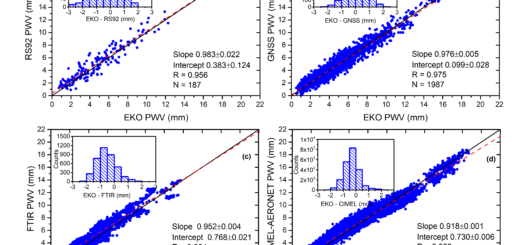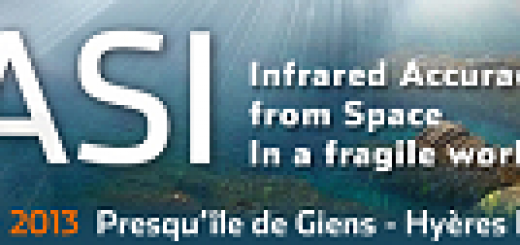New discovery: the mechanism that causes interannual variability in Saharan dust export to the North Atlantic.
The journal Atmospheric Chemistry and Physics (Discussions) publishes a new study performed by scientists of the Izaña Atmospheric Research Centre (AEMET), the University of Miami, CSIC and the University of La Laguna, proposing a new atmospheric conceptual model which has clear connections with climate issues.
Every year between 1 and 2 millions of tons of desert dust are emitted to the atmosphere in North Africa. These emissions are maximum in summer, when the so-called Saharan Air Layer expands from Africa to the Caribbean at subtropical latitudes (15-30º N; Fig. 1). What is the cause of the year to year variability in dust export to the North Atlantic?. Scientists have been searching for an answer to this question during decades.
Fig. 1. Saharan Air Layer in summer, as detected by the number of days with an Aerosol Index > 1.
The journal Atmospheric Chemistry and Physics Discussions publishes a new study performed by scientists of the Izaña Atmospheric Research Centre, the University of Miami, CSIC and the University of La Laguna proposing an answer to that question. The study is based on long term records of airborne desert dust that are being performed in Izaña since 1987, on satellite observations and on meteorological re-analysis.
It is shown that long term inter-annual variability in dust export to the Atlantic is correlated with the intensity of trade winds in Central and Western Algeria. In summers with intense trade winds, dust emissions and export are enhanced, resulting in dusty and hot air that expands over the Canary Islands to the Caribbean.
NORTH AFRICAN DIPOLE
For explaining variability in the intensity of trade winds in the Sahara, the scientific team proposes a new teleconnection index they have so-called North African Dipole, which is related to the difference of geopotentials over the subtropic (Morocco) and the tropic (southern Mali). The intensity of this dipole is measured by the so-called North African Index (NAFDI). The NAFDI is significantly correlated with dust records at Izaña since 1987 (Fig. 2A., Pearson correlation coefficient +0.76). In years with NAFDI values higher than +1, dust concentrations are usually higher than 90 µg/m3, whereas in years with NAFDI values lower than -1, dust concentrations are usually lower than 50 µg/m3 (Fig. 3).
The North African Dipole also influences Sahelian rainfall. Years with an intense dipole (high value of the NAFDI) are associated with intense trade winds in Central Algeria and with a northern shift in the tropical monsoon rain band up to penetrate in the Sahel. In contrast, when the dipole is weak, trade wind intensity diminishes in Central Algeria and drought occurs in the Sahel. For this reason, dust concentrations are Izaña are correlated with rainfall in the Sahel (Fig 2B).
Fig. 2. Time series of dust concentrations at Izaña observatory, NAFDI and Wet Sahel Portion in summers from 1987 to 2012. Green and red arrows highlights periods of intense El Niño and La Niña periods.
Fig. 3. Concentrations of dust at Izaña versus NAFDI in 1987-2012 summers.
NO CHANGES IN THE LAST THREE DECADES
North Africa has two large deserts (Fig. 4): Sahel (14-18ºN) and the Sahara (14-35ºN).
The results of the study show how dust export from the two deserts is negatively correlated by the North African dipole modulation. In summers with high NAFDI values, dust export is important in the Sahara, but not in the Sahel by the action of rainfalls. In contrast, when the dipole is weak, dust emissions lessen in the Saharan by low wind speeds and increase in the Sahel as a consequence of the drought.
Fig. 4. North Africa.
The study shows how since 1987, when dust measurements started at the Izaña Atmospheric Observatory, Saharan dust export has been modulated by wind variability in Central and Western Algeria. In the three last decades (Fig. 2A), the most dusty summers were 1988 (99 µg/m3), 2008 (100 µg/m3), 2010 (118 µg/m3) and 2012 (133 µg/m3), whereas the least dusty summers were 1987 (21 µg/m3), 1997 (17 µg/m3), 2006 (25 µg/m3), 2007 (30 µg/m3) and 2009 (32 µg/m3).
1950s-1060s: HIGH DUST ACTIVITY IN THE SAHARA
Although no significant trends have been detected in dust concentrations in the last three decades, the results of this study suggest that the highest dust export activity from the Sahara desert would have occurred between mid 1950s and mid 1960s (Fig. 5) due to the intense dipole conditions prevailing in that period (Fig. 5); NAFDI based estimations point to mean dust concentrations within the range 70 and 130 µg/m3 in that period (Fig. 5). The decrease in the dipole intensity since mid 1970s detected in this study is consistent with the beginning of the Sahel drought which has tripled the Sahelian dust impacts in the Caribbean.
In summary, the results suggest that the Saharan Air Layer may have been shifted northward between mid 1950s and mid 1960s, which would have increased dust impacts at subtropical latitudes and decreased dust impacts in the tropics with respect to the current situation.
Fig. 5. NAFDI time series, dust measured at Izaña, and estimated dust at Izaña between 1950 and 2012.
CONECTION WITH GLOBAL PROCESSES
Results suggest that the observed variability in the North African Dipole intensity is connected with global processes. Years with low dust concentrations at Izaña tend to occur during intensive El Niño – ENSO periods (1987, 1997 y 2009; Fig. 2A). In contrast, high dust years tend to be associated with intense La Niña periods (1988, 1998, 1999, 2008 y 2010; Fig. 2A). These results suggest that El Niño and the NAFDI variability is influenced by global variability in the climate of tropical and subtropical regions, by influencing the intensity of the trade winds belt.
CLIMATE AND AIR QUALITY
Airborne desert dust influences climate by several mechanisms. Variability in dust loads influence temperatures due to scattering and absorption of light by dust. Dust particles act as cloud water and ice nuclei influencing cloud development and rainfall. Moreover, dust deposited on the ocean releases iron, a fertilizing of marine biota, and this has implications on marine productivity and atmospheric CO2 absorption.
The term air quality has traditionally been linked to the emissions of pollutants in a city or a region. However, desert dust exported from the Sahara contributes to air quality impairment (health effects) in the Atlantic, e.g. Western Africa coast, the Canaries, Cape Verde, the Caribbean and Southern United States, and in the Mediterranean including Southern Europe. The results of this study show how air quality may be significantly influenced by climate variability in Saharan dust export.
GLOBAL ATMOSPHERIC WATCH
This study is based on long term aerosol observations performed at the Izaña Observatory within the frame of the Global Atmospheric Watch program of the World Meteorological Organization and funded by the Meteorological State Agency of Spain (AEMET).
Aerosol dust measurements at the Izaña Observatory:
• are the fourth longest record in the world,
• are the only long term record in the free troposphere,
• are the only worldwide record which includes measurements in several size fractions,
This study was funded by the Ministry of Economy and Competitiveness of Spain within the frame of the project POLLINDUST (CGL2011-26259). Satellite data kindly provided by NASA Goddard Earth Science and re-analysis meteorological data supplied by NOAA Air Resources Laboratory were used.
Publication:
|
Authors: Sergio Rodríguez, Emilio Cuevas, Joseph M. Prospero, Andrés Alastuey, Xavier Querol, Javier López-Solano, María Isabel García, Silvia Alonso-Pérez. Title: Modulation of Saharan dust export by the North African dipole. Publication: Atmos. Chem. Phys. Discuss., 14, 26689–26719, 2014. http://www.atmos-chem-phys-discuss.net/14/26689/2014/acpd-14-26689-2014.html |







